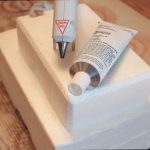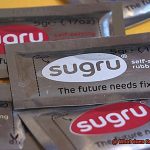Are you sick of staring at that stubborn carpet glue on your concrete floor?
We feel your pain. But fear not, my friend, because we’ve got some tricks up our sleeves to tackle this sticky situation.
Say goodbye to that pesky adhesive and hello to a pristine concrete floor. So, how do we defeat this clingy enemy?
Well, in this blog post, we’re gonna spill the beans on all the methods and products that’ll make your concrete glue-free. From natural remedies to fancy-schmancy commercial stuff, we’ll dive deep into the world of glue removal.
Get ready to kick that tenacious carpet glue’s butt and enjoy a fresh, adhesive-free floor.
Heat as a Method for Removing Carpet Glue
Contents
- 1 Heat as a Method for Removing Carpet Glue
- 2 Chemical Solvents for Removing Carpet Glue
- 3 Mechanical Methods for Removing Carpet Glue
- 4 Factors Affecting the Effectiveness of Removal Methods
- 5 Precautions and Safety Measures During Removal Process
- 6 Professional Help for Carpet Glue Removal
- 7 Preventive Measures to Avoid Future Carpet Glue Issues
- 8 Alternative Flooring Options for Concrete Surfaces
- 9 Conclusion
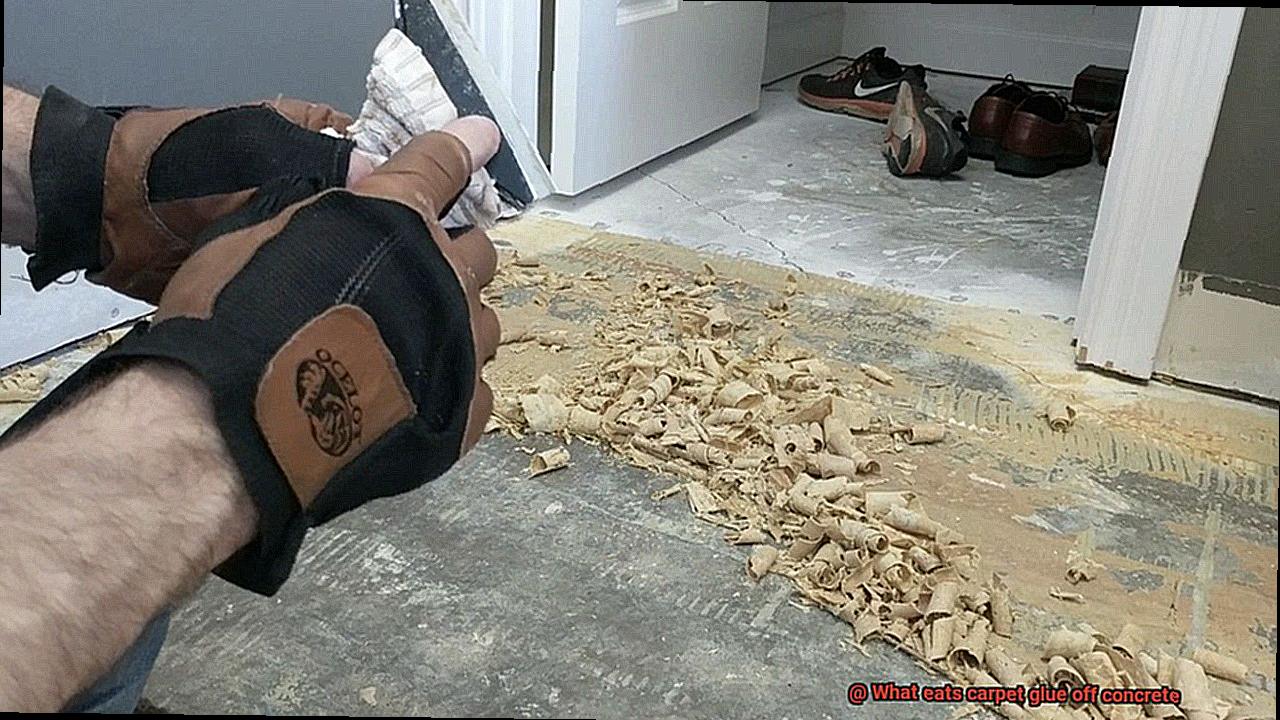
Removing carpet glue from concrete surfaces can be a daunting task, but fear not. With the right technique and tools, you can make this process a breeze. Professionals swear by the power of heat as an effective method for removing carpet glue. In this article, we will explore how heat can be harnessed to effectively eliminate carpet glue from concrete surfaces. Get ready to learn some valuable tips that will help you conquer this sticky challenge with ease.
The Power of Heat:
When it comes to removing carpet glue, heat is the ultimate game-changer. By applying heat to the adhesive, you soften its grip on the surface, making it easier to scrape off. Now let’s dive into the three powerful methods for harnessing heat and their magical effects.
Heat Guns:
One popular tool for removing carpet glue is the heat gun. Imagine a nozzle emitting a stream of intense warmth, set at a distance of 2-4 inches from the surface. As you move it in a sweeping motion, the heat softens the stubborn glue, allowing you to gently scrape it off with a scraper or putty knife. Just remember to keep the gun moving to avoid scorching or damaging the concrete, while ensuring good ventilation for your safety.
Steamers:
Another effective option for tackling carpet glue is utilizing steamers. These handy devices apply hot steam directly onto the adhesive, causing it to loosen and soften. This process makes scraping off the glue a breeze, especially when dealing with larger areas or stubborn spots that refuse to budge.
Infrared Heaters:
For larger areas or thick layers of carpet glue, infrared heaters are your go-to saviors. Emitting radiant heat that penetrates deep into the surface, these heaters work their magic by effectively softening even the toughest adhesive messes. Prepare to witness the glue surrendering to the power of heat, making removal a simple and satisfying task.
Safety First:
As you embark on your carpet glue removal journey using heat, safety should be your top priority. Remember to shield yourself with protective gloves and eyewear to prevent any potential harm. Additionally, ensure proper ventilation in the area to avoid inhaling fumes or toxic substances that may be released during the process.
Finishing Touches:
Once you have successfully removed the carpet glue using heat, it’s time for the finishing touches. Thoroughly clean the surface with mild detergent and warm water to eliminate any residue left behind. This step guarantees a clean and smooth surface for your next flooring project, ensuring a seamless transition from carpet to whatever lies ahead.
Chemical Solvents for Removing Carpet Glue
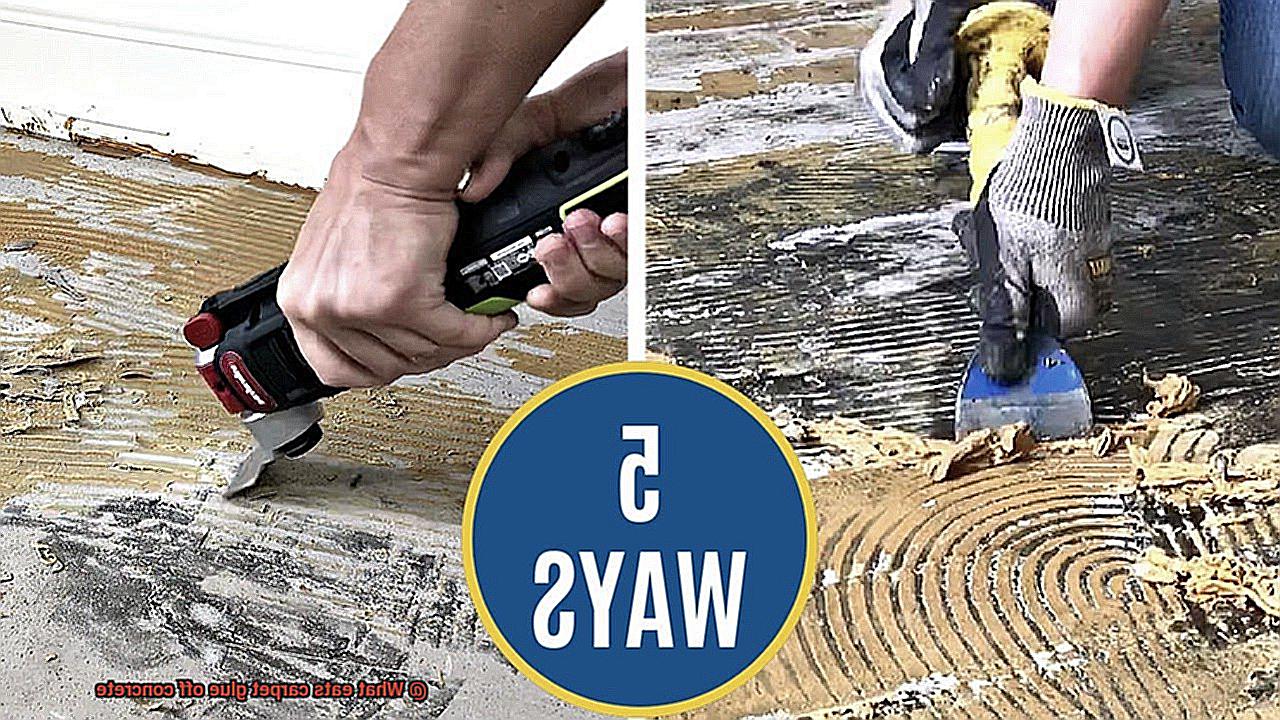
Don’t let stubborn carpet glue get you down. With the right chemical solvents, you can easily remove that adhesive and reveal a clean and smooth surface. In this comprehensive guide, we’ll explore four powerful solvents used for this purpose: acetone, citrus-based solvents, soy-based solvents, and commercial adhesive removers. Get ready to bid farewell to carpet glue and say hello to a refreshed space.
Acetone:
When it comes to breaking down adhesives, acetone is a force to be reckoned with. This potent solvent is readily available and won’t break the bank. To use acetone, simply apply it directly to the carpet glue and let it work its magic for a few minutes. Watch as the adhesive softens, making it easy to scrape away with a scraper or putty knife. Remember to work in a well-ventilated area and protect your hands with gloves, as acetone can be harsh on the skin and emits strong fumes.
Citrus-Based Solvents:
For a safer alternative to acetone, look no further than citrus-based solvents. Derived from citrus fruits, these solvents are not only effective but also kinder to your skin. Available in liquid or gel form, simply apply them directly to the glue using a brush or sponge. Give it a few minutes to penetrate the adhesive, and then gently scrape away the softened glue. Citrus-based solvents not only get the job done but also leave behind a pleasant scent.
Soy-Based Solvents:
If eco-friendliness is important to you, consider soy-based solvents as your go-to option. These biodegradable solvents are made from soybeans and provide an effective solution for removing carpet glue. Apply the product to the glue, let it sit for a few minutes, and watch as it dissolves the adhesive properties. Use a cloth or sponge to wipe away the softened glue effortlessly. Say goodbye to harsh chemicals and hello to an environmentally friendly approach.
Commercial Adhesive Removers:
For specialized solutions, commercial adhesive removers are your best bet. These products are specifically designed for removing carpet glue and can be found in spray or liquid form. They work by breaking down the adhesive properties, making it a breeze to scrape or wipe away. Follow the instructions on the product label for optimal results.
Mechanical Methods for Removing Carpet Glue
Well, don’t let the stubborn carpet glue hold you back any longer. Fear not, because I’ve got some powerful mechanical methods up my sleeve that will help you remove carpet glue like a seasoned pro. Let’s dive right in and discover the secrets to conquering sticky situations.
Scraping:
First on our list is the simple yet effective method of scraping. Armed with a sturdy scraper or putty knife, you can manually scrape away that pesky carpet glue from the concrete surface. With a little elbow grease, this affordable method will have your floors looking glue-free in no time.
Sanding:
But what if scraping doesn’t do the trick? That’s when it’s time to bring in the big guns – sanding. Picture yourself wielding a floor sander equipped with coarse-grit sandpaper, effortlessly erasing those stubborn remnants of carpet glue. Granted, sanding can be time-consuming, especially for larger areas. However, it’s the perfect choice for tackling those extra-sticky situations.
Floor Buffer:

If efficiency is your middle name, then a floor buffer might be your new best friend. Equip it with an abrasive pad specifically designed for adhesive removal, and watch as it works its magic on larger spaces. Just remember to operate the buffer at a low speed to avoid any damage to the concrete surface. With this method, you’ll enjoy an even removal process that leaves your floors gleaming.
Heat Application:
Ah, the heat is on. When faced with particularly resistant carpet glue, it’s time to bring out the heat guns or hot air blowers. Apply heat to soften the glue and make it easier to scrape or peel off. But be sure to tread carefully and avoid excessive heat, as it can damage the concrete surface.
Factors Affecting the Effectiveness of Removal Methods
I am here to shed some light on the factors that can make or break your glue removal mission. So grab your scrapers, solvents, and a can-do attitude because we are about to dive into the captivating world of effective removal methods.
First and foremost, let’s talk about the strength of the solvent. When it comes to battling that pesky carpet glue, you need a heavy-duty solvent in your corner. Acetone and paint thinner are popular choices that can break down the adhesive properties of the glue, making it a breeze to scrape away. But beware, these mighty solvents must be used with caution, as they have the power to wreak havoc on your concrete surface if mishandled. So let us tread lightly on this path of removal.
Now, let us discuss the concept of dwell time. Just like a fine wine that needs time to mature, solvents need time to work their magic. Patience is key here, my friends. Allowing the solvent a few precious minutes to penetrate and dissolve the glue will greatly enhance its effectiveness. So resist the urge to rush the process and savor this moment of anticipation.
Ah, temperature, an often overlooked factor in glue removal. The power of heat should not be underestimated. Applying heat can soften the adhesive properties of the glue, making it a mere whisper in the wind. Grab your trusty heat gun or pour some scintillating hot water on that stubborn glue and watch as it loosens its grip on your precious concrete surface.
But wait, my friends, there is more to this tale. Surface preparation is an essential part of this grand endeavor. If your concrete surface has been previously sealed or treated with a protective coating, removing carpet glue may require some extra elbow grease. Sanding or using a specialized primer can be the key to unlocking the true potential of your removal methods. Prepare the canvas, my friends, and let us embark on this artistic journey of glue removal.
Last but certainly not least, let us not underestimate the power of physical agitation. Sometimes, a little muscle is needed to conquer those layers of stubborn glue. Embrace your inner warrior and wield your scraper or brush with confidence. Loosen and lift that adhesive, but remember to handle your weapons with care so as not to damage your precious concrete surface in the process.
Precautions and Safety Measures During Removal Process
In this blog post, we will delve into the precautions and safety measures necessary to conquer the challenge of carpet glue removal from concrete. Prepare yourself, don your safety gear, and let us embark on a journey through the realm of adhesive liberation.
Personal Protective Equipment (PPE):
Before engaging in battle, equip yourself with the appropriate PPE. Gloves will shield your hands from harmful chemicals, while goggles will protect your precious eyes from any accidental splashes. And do not neglect the trusty respirator – a loyal companion that safeguards your lungs against inhaling potentially hazardous fumes.
Ventilation is Key:
Remember, fresh air is your ally. Throw open those windows wide or utilize fans to keep the air flowing during the removal process. Adequate ventilation helps dissipate fumes and prevents them from accumulating to dangerous levels.
Illuminate Your Path to Glory:
Never underestimate the power of proper lighting. Ensure you have ample illumination in your work area. This will enable you to spot any potential hazards or spills that may impede progress or cause accidents.
Clear the Battlefield:
Prior to commencing your epic battle, remove all furniture and obstacles from the area. A clutter-free environment ensures a safe working space, reducing the risk of tripping or falling over objects.
Heed the Call of Instructions:
When utilizing chemical-based adhesive removers, diligently respect and follow the manufacturer’s instructions. Each product may have specific guidelines for usage and safety precautions. Some might require dilution or necessitate particular application techniques – so read those labels carefully.
No Smoking Allowed:
Avoid smoking or exposing open flames near the removal process. Certain adhesive removers can be highly flammable, posing a fire hazard. Let us focus on removing glue, not igniting unintended infernos.
Take a Breather:
If engaged in a prolonged removal process or working with a substantial quantity of adhesive remover, remember to take regular breaks. Step away from the battlefield, breathe in some fresh air, and allow your body to recover from exposure to potentially harmful fumes.
Dispose of Waste Responsibly:
Dispose of any waste materials, including used gloves and adhesive remover-soaked rags, in accordance with local regulations. Some adhesive removers may be classified as hazardous waste, requiring special handling or disposal methods. Let us keep our environment safe from the aftermath of our heroic exploits.
First Aid: Your Trusted Comrade:
Last but never least, have a readily available first aid kit. Accidents happen, and it is always wise to be prepared for minor injuries that may occur during the removal process. Familiarize yourself with the contents of your kit and know how to use them effectively.
Professional Help for Carpet Glue Removal
That’s where professional carpet glue removal services come to the rescue. In this article, we’ll delve into the myriad benefits of enlisting professional assistance for this arduous task, guaranteeing a thorough and effective solution while safeguarding your concrete from harm.
Efficiency and Time-Saving:
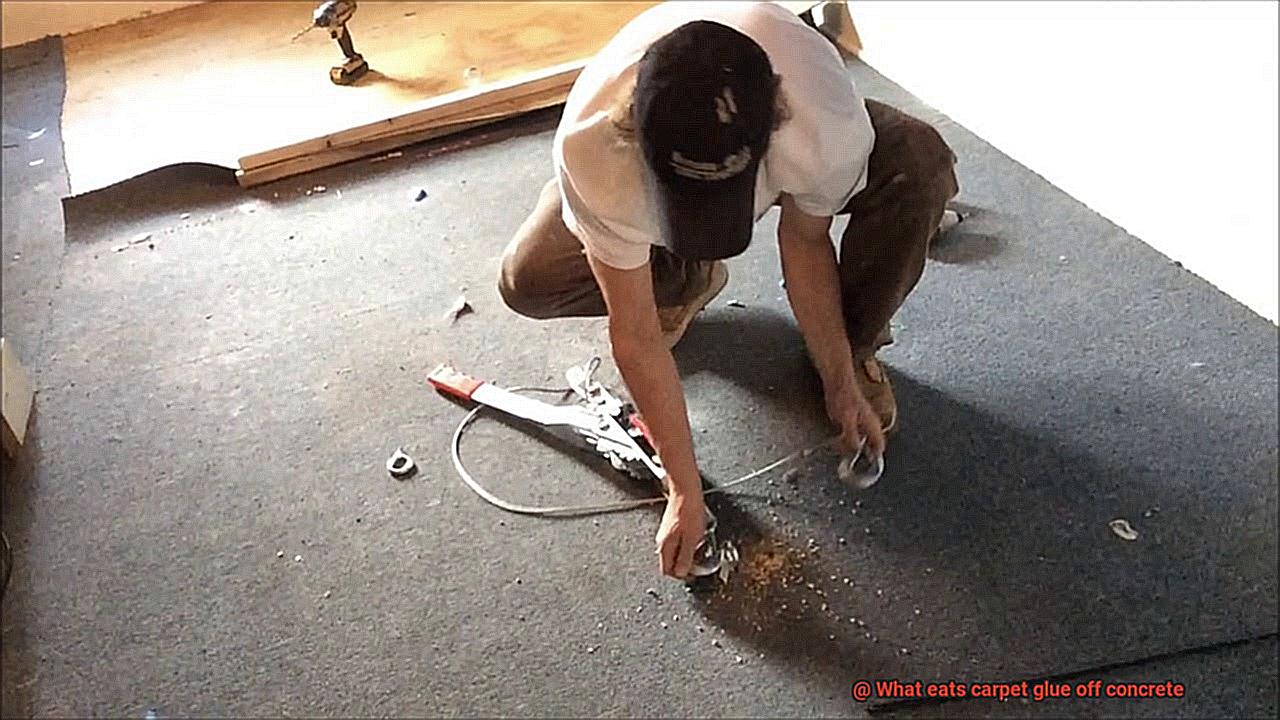
Say goodbye to wasted hours grappling with trial-and-error methods. Professional technicians, armed with their wealth of experience, possess the necessary tools and equipment to conquer even the most stubborn of stains. By entrusting professionals with the job, you’ll save precious time and effort that can be better spent on other tasks.
Specialized Products and Techniques:
Professional carpet glue removal services employ top-of-the-line solvents and adhesive removers specifically formulated to dissolve glue without damaging your concrete. These products pack a powerful punch, breaking down the stubborn residue while treating your concrete surface with utmost care. Seasoned experts know which techniques to deploy based on the extent of the glue residue and the condition of your concrete, ensuring optimal results.
Safety:
Chemicals found in some adhesive removers can pose risks if handled improperly. Professionals are well-versed in safely managing these substances, mitigating potential hazards. By enlisting professional help, you prioritize your safety, sidestepping any accidents or health concerns.
Damage Prevention:
Concrete surfaces are delicate and susceptible to damage if not handled with finesse during glue removal. Professional technicians possess invaluable knowledge and expertise in assessing the condition of your concrete, determining the most suitable method for glue removal without causing harm. With professionals at the helm, you can rest assured that your concrete will emerge unscathed.
Guidance for Future Maintenance:
Beyond delivering impeccable results, professionals offer indispensable advice on preventing future glue stains on your concrete surface. They can recommend protective measures or maintenance routines that will preserve its cleanliness and prolong its lifespan, saving you from future headaches.
Preventive Measures to Avoid Future Carpet Glue Issues
Are you tired of dealing with carpet glue issues? Worry no more. With these preventive measures, you can keep your carpet glue intact and your floors looking fabulous. Let’s dive into some practical tips that will save you from sticky situations.
- Hire a Skilled Installer: Improper installation is a major cause of carpet glue problems. Invest in a professional installer who follows proper techniques and uses high-quality adhesive. This will save you from future headaches and hefty repair bills.
- Prepare the Surface: Before installing the carpet, ensure that the concrete surface is clean, dry, and smooth. Take extra steps to prevent moisture from seeping into the concrete and causing the glue to deteriorate. Use moisture barriers or sealants to protect the bond between the carpet and the glue.
- Regular Maintenance and Cleaning: Keep dirt and spills at bay by regularly vacuuming your carpet. Tackle spills immediately to prevent them from seeping into the concrete and damaging the adhesive. Consider using protective mats or rugs in high-traffic areas or spots prone to spills to minimize wear and tear on your carpet glue.
- Promptly Address Issues: Don’t let small issues turn into big problems. Address water leaks or spills promptly to prevent them from affecting the adhesive. Stay vigilant and look out for signs of damage or loosening glue, such as bubbling or wrinkles. Take immediate action if you spot any trouble.
- Gentle Cleaning Techniques: When cleaning spills or stains, opt for mild cleaners and blot instead of rubbing vigorously. This will help you remove stains without damaging the delicate bond between the carpet and glue.
- Regular Professional Inspections: Schedule regular inspections by professionals who can spot potential issues early on and address them before they become major problems. Their expertise will provide peace of mind and ensure the longevity of your carpet glue.
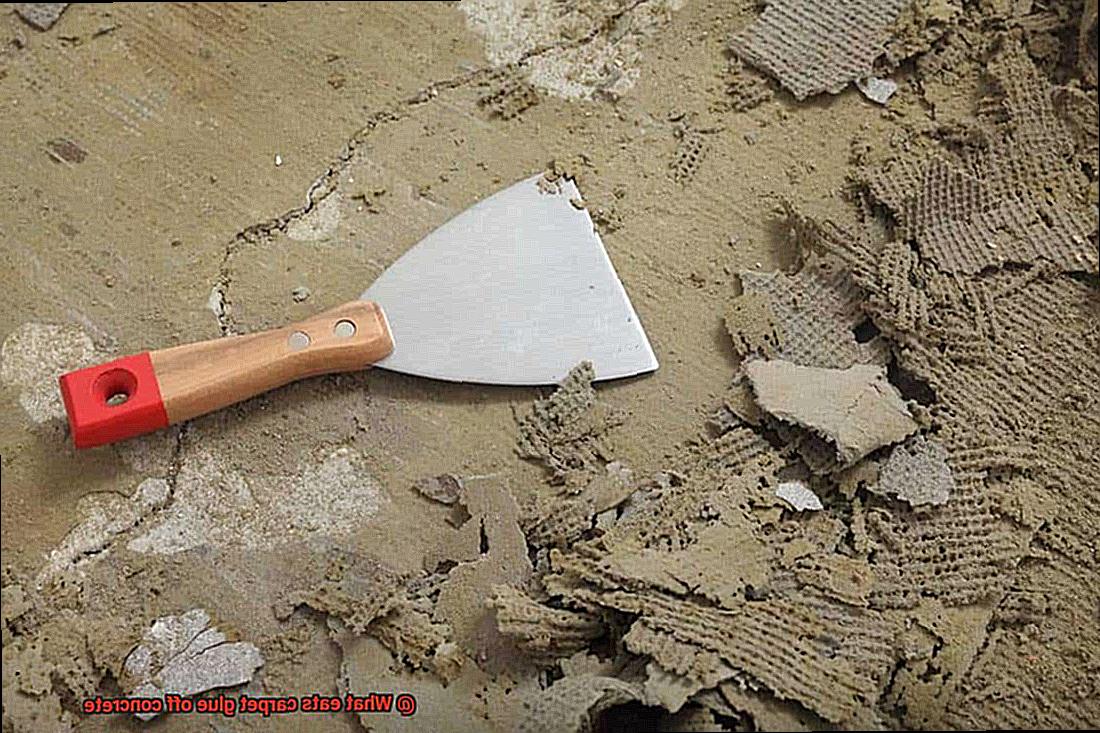
Alternative Flooring Options for Concrete Surfaces
Fear not, for there are numerous alternative flooring options that can completely revamp the ambiance of your space. Whether you crave a sleek modern aesthetic or a cozy rustic vibe, there is something to cater to every taste. In this article, we will delve into popular flooring alternatives for concrete surfaces, exploring their advantages and important considerations.

Laminate Flooring:
- Emulates the elegance of hardwood, tile, or stone
- Versatile and cost-effective choice
- Simple installation and low maintenance
- A perfect option for DIY enthusiasts
Vinyl Flooring:
- Available in a myriad of styles and designs
- Highly resilient and moisture-resistant
- Ideal for basements or bathrooms
- Effortless cleaning and upkeep
Concrete Staining:
- Offers an extensive range of colors
- Customizable patterns and designs
- Imparts a sleek and modern appearance
- Enhances the innate beauty of concrete
Acid-Etched Concrete:
- Creates a captivating textured and mottled look
- Harmonizes seamlessly with staining for personalization
- Exudes a natural and rustic charm
- A haven for those with an artistic inclination
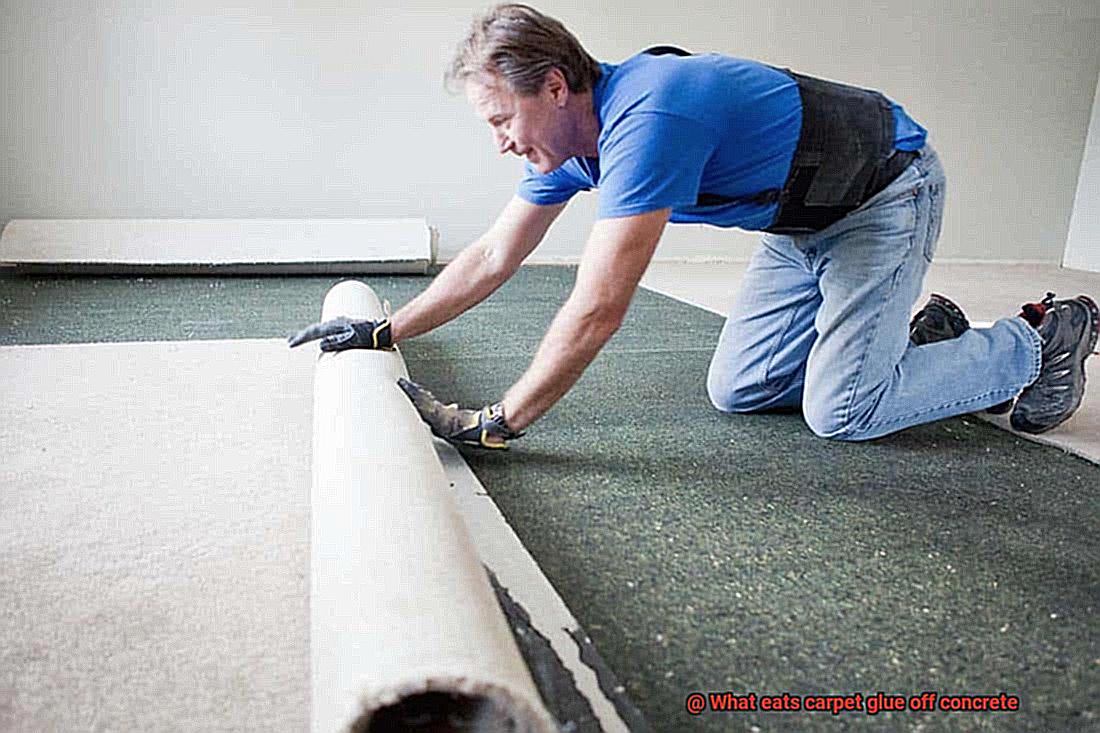
Polished Concrete Flooring:
- Boasts a smooth finish with added durability
- Exudes opulence and elegance
- Visually striking with minimal upkeep required
- Highly durable and long-lasting
Carpet Tiles:
- Provides a soft underfoot feel
- Simple installation and replacement process
- Perfect for high-traffic areas
- Offers insulation properties and noise reduction
Epoxy Resin Coatings:
- Offers a one-of-a-kind and artistic flooring option
- Showcases stunning visual effects like metallic finishes or 3D designs
- Highly durable and stain-resistant
- Ideal for both residential and commercial spaces
z3MaDZAXA2o” >
Conclusion
Carpet glue on concrete can be a stubborn and unsightly problem.
There are solutions that can eat away at this sticky mess. One such option is acetone, a potent solvent that can dissolve the adhesive bond between the glue and the concrete surface.
Another contender in the battle against carpet glue is citrus-based cleaners, which harness the power of natural acids to break down and remove the sticky residue. For those who prefer a more eco-friendly approach, vinegar mixed with warm water can also do wonders in loosening and removing carpet glue from concrete surfaces.
So whether you opt for the strong punch of acetone, the zesty freshness of citrus cleaners, or the gentle touch of vinegar, rest assured that there are effective methods to devour that carpet glue off your concrete floors.


